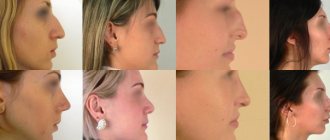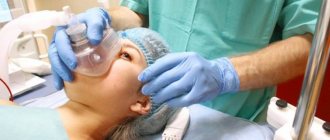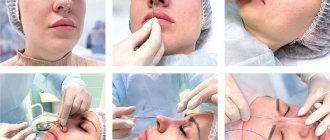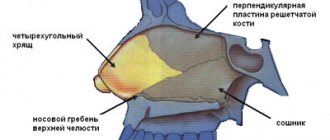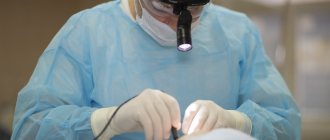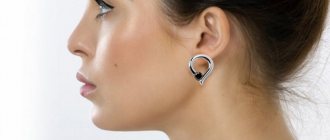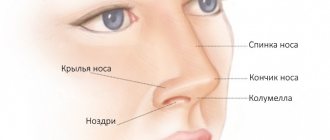Myth 2. Plastic surgery should only be done in adulthood.
This statement indicates ignorance of the intricacies of plastic surgery.
Each operation has a recommended age: for example, otoplasty (ear surgery) is performed from 7 years of age (but according to indications), rhinoplasty and mammoplasty - from 18 years of age, facelift - according to indications. Remember that plastic surgery is performed not only on patients who want to transform themselves and look younger, but also for medical reasons.
Myth 3. Scars will remain.
You can now forget about scars and cicatrices after surgery forever. Specialists are now performing minimally invasive, gentle techniques that require minimal recovery.
Of course, everyone’s body is different and some patients have a tendency to form scars, but in these cases it is necessary to contact plastic surgeons who know how to care for patients using therapeutic and physiotherapeutic methods. Unfortunately, there are few such plastic surgeons.
Another example: facial plastic surgery with threads. Using special threads, a plastic surgeon tightens the skin on the patient’s face without surgery. Some of them dissolve over time, creating a natural frame, and some remain forever, reinforcing the natural frame.
Myth 4. Implants cause cancer.
Implants do not affect the behavior of cancer cells. The risk of getting cancer after breast augmentation is the same as before the installation of endoprostheses: it all depends on genetics and lifestyle. Even if the implant is installed incorrectly and the wrong shape is chosen, there will be no such risk.
Regarding mammoplasty, women also often believe that breast enlargement is not possible before pregnancy. But in fact, this does not in any way affect the physiological processes occurring in a woman’s body. No one can guarantee that after childbirth the breast shape obtained after plastic surgery will remain the same. But it is absolutely not necessary to remove the implant before pregnancy - it does not in any way disrupt the lactation function of the mammary gland.
Myth 5. Complications after plastic surgery are deadly.
Any surgical procedure involves some risk. Any complication or inflammation can occur after any other procedure, not necessarily only after plastic surgery. The final result depends on the level of professionalism of the surgeon, the correctness of the operation and compliance with all rules during the rehabilitation period.
Myth 6. Getting plastic surgery is a shame.
This prejudice originated in the middle of the last century, when it was believed that a woman with natural beauty should not use cosmetics or resort to any complex manipulations.
Natural beauty is wonderful! But over time, the first wrinkles appear on the face of any person, and frequent stress and a fast-paced lifestyle lead to the appearance of the first skin imperfections and excess weight.
From a psychological point of view, any actions aimed at increasing self-confidence are always very good. And plastic surgery increases self-confidence, which inevitably brings success in life. Plastic surgery helps create the desired first impression.
In addition, plastic surgeries performed using modern equipment and technologies give natural results.
Myth 7. A facelift makes it look like a doll.
Modern techniques for facial plastic surgery not only tighten the skin, as in former times, but also evenly redistribute all layers of facial tissue relative to each other. As a result, the face becomes fresh, youthful with the natural smoothness of a lively face. As a rule, what makes a doll-like face is either the surgeon’s lack of professionalism or the patient’s desire to look like that.
Myth 8. Plastic surgery is done once for a lifetime.
The effect of plastic surgery lasts for about 8-10 years. But any type of facial plastic surgery has a temporary effect due to the fact that not a single plastic surgery stops time and does not affect the biochemical processes occurring in cells.
But, of course, the result of operations such as otoplasty and rhinoplasty will remain forever, since no additional deformations occur in this place during life, or the changes are not great.
Myth 9. Plastic surgery cannot be performed in the summer.
Surgery can be performed at any time of the year, whenever you decide or the surgeon prescribes. The only thing you need to understand is that after the operation you need time for rehabilitation. It is better to plan it without scheduling things that could interfere with successful and easy rehabilitation.
The first day, as a rule, is spent in well-equipped and comfortable rooms with air conditioning and other amenities. Another thing is that summer is vacation time and you don’t want to spend it in a hospital room. But that's up to you to decide.
Myth 10. Liposuction allows you to get rid of cellulite forever.
Unfortunately, liposuction is not capable of completely evening out the relief: this technique has a completely different task - to remove fat deposits. Cellulite can be dealt with by proper nutrition, exercise and the right combination of cosmetic procedures after liposuction.
In what cases should plastic surgery not be performed?
- Oncological diseases. Tissue transfer during surgery can move dangerous, infected cells to healthy areas of the body.
- Diabetes mellitus provokes diseases and dysfunction of internal organs, decreased blood circulation during surgical interventions, and as a result the skin may die.
- Hemophilia is a bleeding disorder that causes severe bleeding during surgery.
- Acute infectious diseases. During such diseases, immunity is lowered and the body is weakened. There is an increased risk of the spread of pathogenic microorganisms; surgery can lead to sepsis.
- Pregnancy and lactation period. Medicines used during surgery have a negative effect on the fetus. In addition, surgery is a great stress for the whole body.
- Minor age. All surgical operations are performed on patients over 18 years of age. Exceptions are ENT operations, which are performed even on children.
- A long history of smoking leads to a long process of tissue regeneration, which means a long recovery period.
- The menstrual cycle increases bleeding during surgery.
- Old age of the patient. People over 65 years of age are less able to tolerate anesthesia and stress during surgery. Therefore, the patient must undergo all necessary tests in advance.
- Keloids. There is a high probability of formation of a convex scar at the incision site. The keloid scar is constantly growing and causes anxiety (itching, pain).
Impact principle
Due to the injected volume of gel, the skin fold is pushed out, as a result of which the wrinkle is smoothed out or tissue deficits are filled (cheekbones, lips, cheeks).
The drugs are injected with a very thin needle into certain areas of the face.
The uniqueness of the drugs is that when they enter the skin, they naturally combine with their own hyaluronic acid and complement it. Metabolic processes improve, and the skin becomes more elastic and firm.
Lip augmentation with hyaluronic acid gives such a rejuvenating effect after injections, which is visible immediately, and minor redness and swelling that may be observed after the procedure disappear very quickly.
What should you not be afraid of with plastic surgery?
Most often, a patient’s fear of plastic surgery appears because of stories in the media about unsuccessful surgical interventions or because of the unsuccessful experience of a friend. Everything gets worse if loved ones are categorically against it and discourage you from having plastic surgery.
The patient experiences fear:
- Something won't go according to plan. An experienced surgeon performs operations every day, which means he is ready for any turn of events.
- Anesthesia. It is frightening to realize that the patient cannot influence the course of the operation. But anesthesia allows the surgeon to effectively perform operations and the patient not to experience pain.
- Scars and scars. They are afraid that noticeable scars will make the body unaesthetic. Surgeons are proficient in “invisible suture” techniques, which are unnoticeable after rehabilitation.
New nose? Transplantation is your choice!
- home
- Rhinoplasty
- New nose? Transplantation is your choice!
Grishkyan David Rubenovich plastic surgeon
Undoubtedly, the nose is the most “prominent” part of the face. And it often happens that people are openly dissatisfied with the nose that was given to them from birth. Of course, every face should have harmony, and its violation attracts attention, as they say, hurts the eye. This does not just cause a person a momentary irritation when looking at himself in the mirror, but very often reduces his self-esteem and leads to many complexes, and women are more susceptible to this. And it is the fair sex who most often turn to plastic surgery , wanting to change their nose.
The first thing a plastic surgeon does is conduct a comprehensive diagnosis of the patient’s entire face, and the nose is considered not as a separate part of the face, but as one of its constituent parts. It is this approach that can subsequently ensure successful rhinoplasty, the best result of which we consider is the achievement of an optimal ratio of facial proportions, maintaining its naturalness and desired harmony. Of course, we carry out comprehensive diagnostics taking into account the individual needs of each patient.
When performing rhinoplasty, we use cartilage autografts. To do this, during the operation, cartilage is taken from the patient's nasal septum or ears. If it is impossible to take cartilage from these areas, we use rib cartilage. Cartilaginous autografts are required to sculpt the tip of the nose , as well as to give it shape. In addition, with the help of cartilage autografts, the tip of the nose is strengthened, which prevents its further modification or drooping.
In our clinic, the following cartilage autografts are most often used: “rafters” (we place it between the medial legs of the wing cartilages); shield-graft (an implant that we place on the tip of the nose); spreader-graft (implant with which the bridge of the nose ). It is clear that we have listed only a small part of autografts, but in total there are more than twenty of them used in rhinoplasty.
The “rafter” is a narrow, rectangular piece of cartilage that comes from the nasal septum. It is placed between the medial crura with emphasis on the nasal axis. The “rafters” measure from 2-2.5 centimeters long and no more than 2-3 millimeters wide. With the help of a “rafter”, the tip of the nose is strengthened and, if necessary, lengthened, thereby subsequently preventing its drooping.
The nose after rhinoplasty differs from the non-operated nose in that after the operation the so-called defining points on the tip of the nose disappear.
And the point of transplantation using a “rafter” is to restore, to reconstruct these points anew, which makes it impossible for even a specialist to see the difference between a natural and an operated nose .
And with the help of the “rafter” you can regulate the rotation of the tip of the nose and its length. Spaider-graft autografts – “autocartilage” of the “rafter” type, are placed between the quadrangular cartilage and the nasal septum. With their help, we reduce the height of the nasal bridge or, if necessary, remove the cartilaginous part of the hump. With the help of Spaider-graft autografts, the volume of the nasal strip, as well as the dorsum of the nose, is expanded. And this is important, since by reducing the external size of the nose, we, accordingly, reduce its internal size, but at the same time it is necessary to maintain the volume of the nasal cavity for the intake of a normal volume of air.
Indications for the use of implants at the root of the nose are rare, which is why we use them less often than those previously listed. Typically, such an operation is required for patients with a long nose and a “heavy look,” that is, those who have an incorrect position of the projection of the nasal root in relation to the entire face.
What is interesting is that such patients, wanting to change the “heavy look”, seek to undergo eyebrow and forehead surgery, while the whole problem lies precisely in the deep root of the nose. Moreover, practice has shown that changes in the back of the tip of the nose do not change the overall facial expression, but if you install an implant in the area of the root of the nose, the effect is striking: the face becomes open and harmonious, and its expression soft and welcoming.
We have long been convinced that the use of cartilage autografts allows us to obtain the most harmonious and natural effect, and, in addition, it helps to improve and restore nasal breathing function. Moreover, cartilage autografts are irreplaceable in cases where, for one reason or another, it is impossible to use other methods.
Rhinoplasty (nose job) cost of surgery
| Operation name | Cost in rubles |
| Total rhinoplasty | 350000 300 000 |
| Repeat rhinoplasty (nose job after rhinoplasty by another surgeon) | 400000 |
| Rhinoplasty of the tip of the nose | 230000 |
| Septoplasty (ENT surgery to correct the nasal septum) | 150000 |
| Plastic surgery of the nasal bridge with removal of the hump | 230000 |
| Elimination of deformation of the wings of the nose | 50000 |
Make an appointment
What are the real risks of plastic surgery?
Plastic surgery, like any operation, is always stressful for the body. The surgeon is obliged to honestly talk about all possible complications of surgery.
- Thromboembolism. With thromboembolism, blood clots form in the large veins of the legs or pelvis. When these blood clots break off and travel to the lungs, the pulmonary arteries become blocked.
- Damage to nerve endings. A common occurrence after surgery is numbness. Sensitivity returns 6-12 months after surgery. But in some cases, the nerve endings remain damaged forever.
- Infection and injury to internal organs. During the operation, perforation (puncture) of internal organs is possible, which can lead to infection, malfunction of the damaged system, or a heart attack.
- Hematomas and seromas. This is the accumulation of blood under the skin, resulting in painful bruising. With seroma, tissue fluid accumulates under the skin due to rupture of small vessels, causing a tumor or abscess to appear. Seromas must be drained, that is, dried, since the liquid contents may contain infection.
History of origin
Originating in the 70s of the 20th century, the filling technique has become one of the main ones in facial aesthetic medicine.
In cosmetology, the contour plastic method was first used in 1977 in the USA. In France, the technique was officially introduced in 1981. To this day, the technique is constantly being improved; new materials are constantly appearing on the market, which indicates its vitality and demand. Over the past two decades, soft tissue augmentation with various fillers has become an extremely popular procedure.
Contour plastic surgery is plastic surgery without surgical intervention, which allows you to solve various problems:
- remove mesh around eyes
- face oval correction
- smooth out expression wrinkles
- eyelid correction
- face lift
- contour plastic surgery of nasolabial folds
- overall facial rejuvenation
- increasing lip volume
Ask a question or sign up online
+7 (347) 2-466-744 Call me back
Sign up
Should I decide on plastic surgery or not?
Only you can answer this question yourself. If this is not a medical indication, but only a tool for transforming yourself, you should determine for yourself whether you are emotionally and physically ready to undergo surgery. Make an appointment with a surgeon and consult with your doctor. You can first study additional information on official medical websites.
You can have plastic surgery in Krasnoyarsk at the effi plastic surgery clinic. We care about the health of our patients during and after surgery, so we carefully monitor all changes in your body and only accept for surgery those who are ready both mentally and physically.
Results (before-after)
11
Correction of facial wrinkles around the eyes using Xeomin and Belotero Soft
Correction of facial wrinkles around the eyes using Xeomin and Belotero Soft
Correction of expression wrinkles around the eyes using Xeomin and Belotero Balance
Correction of expression wrinkles around the eyes using Xeomin and Belotero Balance
Correction of nasolabial folds using Belotero Intens
Lip contouring (Belotero Balance 1.0)
Lip contouring (Juvederm Ultra Smile 0.55 ml)
Correction of nasolabial folds (Belotero Intens 1.0 ml)
Correction of nasolabial folds using Ial-System Duo
Correction of facial wrinkles on the forehead using Xeomin and Belotero Balance
Lip contouring using Juvederm Ultra Smile
Features of non-surgical rhinoplasty of the nose
The effect of nose contouring with fillers lasts from ten months to 2-3 years. During this time, the drug is slowly and gradually absorbed. It happens that the filler induces the formation of fibrous tissue at the injection site. Then the effect lasts much longer.
To monitor the result of the operation and the behavior of the drug in the injection area, repeated examinations may be necessary with the specialist who performed the injection.
Contour plastic surgery does not allow deep changes in the topography of the nose (in case of deviated septum, fractures of the nasal bones, etc.). It will also not help restore nasal breathing caused by congenital or acquired deformities of the septum or bones. However, this is a quick, simple and completely safe way to “disguise” minor cosmetic defects.
Urological surgeries
Urologists at the Promedicina clinic will conduct diagnostics, conservative and surgical treatment of diseases of the genitourinary system. Our doctors perform the following types of surgical interventions:
- excision of the foreskin (circumcision);
- Bergmann or Winkelmann surgery for hydrocele of the testicular membranes;
- excision of epididymal cysts;
- removal of polyps of the urethra (urethra) using the radio wave method;
- surgical treatment for varicocele (Marmara operation - microsurgical ligation of the veins of the spermatic cord);
- Meatotomy (dissection of the external opening of the urethra due to its pathological narrowing);
- surgical treatment for phimosis and balanoposthitis.
About outpatient services of a urologist

